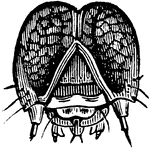
Hop Louse
"Hop louse which lives on the plum tree in the late fall, winter, and early spring until the hop vines…

Archerfish
"Toxotes jaculator, a scaly-finned, acanthopterygian fish, about 6 in. long, inhabiting the seas around…

Edward Lear's Rhymes
There was an old man at a casement, who held up his hands in amazement; When they said, "Sir, you'll…

Edward Lear's Rhymes
There was an old man of Nepaul, from his horse had a terrible fall; But, though split quite in two,…

Air Pump
Sprengel's Air-pump is a glass tube longer than a barometer tube, down which mercury is allowed to fall…

Ganymede
"Hebe was dismissed from her office in consequence of a fall which she met with one day when in attendance…

Newt
The common name applied to various classes of amphibians closely resembling the salamanders. The form…
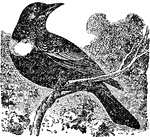
Ring Ouzel
A species of thrush native to Eurasia, which resembles in size and appearance the blackbird. It is migratory,…
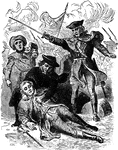
Montcalm
This image shows the death of Louis-Joseph de Montcalm. Montcalm was the commander of the French forces…
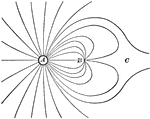
Electricity
This illustration shows the lines of force when a positive charge equal to 4 at A, and a negative charge…
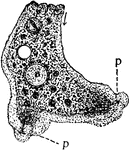
Amoeba
The streaming of Protoplasm in the Amoeba. The forward motion of the granules takes place more rapidly…
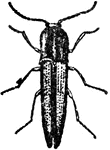
Click Beetle
"Springing Beetles, Elateridae, are narrower and more elongate than the former, and their legs are so…
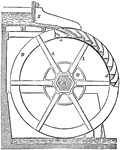
Water Wheel
"When a water fall ranges between 10 and 70 feet, and the water supply is from 3 to 25 cubic feet per…
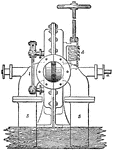
Reaction Turbine
"Professor James Thomson's inward flow or vortex turbine has been selected as the type of reaction turbines.…
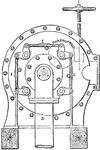
Reaction Turbine
"Professor James Thomson's inward flow or vortex turbine has been selected as the type of reaction turbines.…
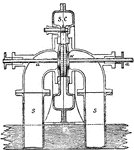
Reaction Turbine
"Professor James Thomson's inward flow or vortex turbine has been selected as the type of reaction turbines.…
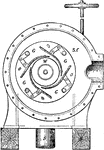
Reaction Turbine
"Professor James Thomson's inward flow or vortex turbine has been selected as the type of reaction turbines.…

Center of Gravity
"Why does a person carrying a weight upon his back stoop forward? In order to bring the center of gravity…
Centrifugal Force
"When a vessel containing water is whirled rapidly round, why does not the water fall out when the vessel…

Lace Machine
"A section of part of a lace machine. E is the cylinder or beam upon which the lace is rolled as made,…
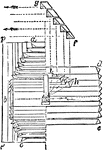
Condensing Octant
"Condensing Octant.—The central fixed apparatus bb with spherical mirror dd throws its rays directly…
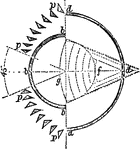
Condensing Octant
"Condensing Octant.—The central fixed apparatus bb with spherical mirror dd throws its rays directly…

Atwood's Machine
"Atwood's Machine. This difficulty has however been overcome by a curious piece of machinery invented…
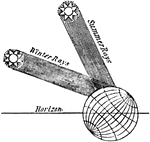
Rays
"Summer and Winter rays.—Let us suppose that the rays falling perpendicularly on a given extent…
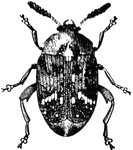
Pea Weevil
"Pea weevil; adult. The pea weevil (Bruchus) is often found in peas in its larval state during summer…

Pea Weevil
"Pea weevil; pupa. The pea weevil (Bruchus) is often found in peas in its larval state during summer…

Air-Pump
"This was invented in 1865 by H. Sprengel. The instrument, in its original (simplest) form, consists…

Vertical Line
That an accurate notion of the vertical line may be obtained, the plane of the picture must be supposed…

Moth Lantern
From the well known nocturnal habits of moths, and the certainty of their being destroyed by a light,…
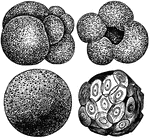
Foraminifera
These animalcule are so small that 1,000,000 are equal in bulk to only one cubic inch. They appear to…

Diagrammatic Representation of Spectroscope
"The light to be studied is admitted through a narrow slit (A) in the end of a tube, in such a way that…

Center of Gravity of Standing Blocks
"Where five blocks are placed in this position, the point of gravity is near the centre of the thrd…

Projectile Motion of a Cannonball
"Suppose a cannon be loaded with a ball, and placed on top of a tower, at such a height from the ground,…
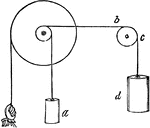
Wheel and Axle
"To change the direction, it is only necessary that the rope by which the weight is to be raised, should…
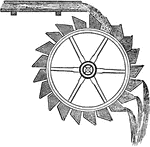
Overshot Wheel
"This wheel of all others, gives the greatest power with the least quantity of water, and is, therefore,…

Breast Wheel
"In this water, instead of passing over, or entirely under the wheel, is delievered in the direction…
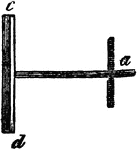
Reflection of Light
"Thus, if a sunbeam, passing through a small aperure in the window shutter a, be permitted to fall upon…
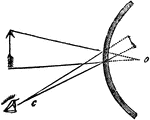
Convex Mirror
"...as the arrow is moved backwards, the angle at c, must be diminished, because the rays flowing from…

Diverging Rays from a Double Convex Lens
"If diverging rays fall on the surface of the same lens, they will, by refraction, be rendered less…
Refracting Telescope
"Suppose the object o to be at such a distance, that the rays of light from it pass in parallel lines,…
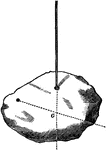
Finding the Center of Mass
"Let any irregularly shpaed body, as a stone or chair, be suspended so as to move freely. Drop a plumb…







